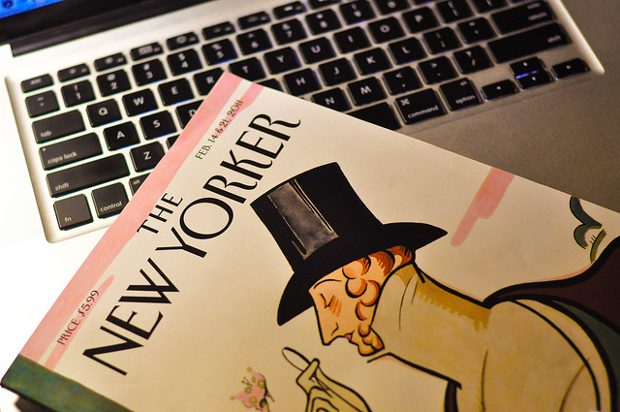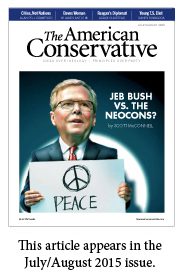Getting It Write

There’s a lot not to like about The New Yorker—the juxtaposition of its high-left Manhattan concern for the plight of the oppressed with ads for products that pay tribute to the joys of income inequality; lead editorials by the hopelessly Obamaphilic editor, David Remnick; occasional whacko economic columns; neurotic fiction; Joyce Carol Oates.
Then there are the good things that have kept us reading over the years—extended pieces by writers like John McPhee and William F. Buckley Jr., a favorite of the legendary editor, William Shawn; “Wayward Press” features by A.J. Liebling, as well as his remarkable dispatches on prize-fighting; Pauline Kael; “Block That Metaphor”; the cartoons; and the consistently high quality of the product itself.
Mary Norris, a copy editor charged with helping the magazine enforce its high standards, and the author of this splendid book, is an admirable woman totally immersed in and loving her work with words, writing, and writers—in no way pedantic and only mildly prescriptive, her own writing easy and unpretentious, touched throughout with genial good humor. In a wonderful introduction, she retraces her early work history, probably not quite the career path we’d imagine for a typical New Yorker employee—at 15, for reasons of sanitation, “checking feet at a public pool in Cleveland”; after graduation from Douglass College at Rutgers, a job at the Cleveland Costume Company, where “I learned to repair big papier-mache animal heads and not to paint the panther’s eyes blue.”
“I called a local dairy and asked whether there were any openings for milkmen.” She fantasized about owning a dairy farm, she tells us. And she liked cows. “‘We’ve never had a lady drive a milk truck, but there’s no reason not,’ a man said….” She mastered driving a dual-transmission truck, survived a crash, and was given her own milk-delivery route.
You put the milk in a chute, she tells us, and shouted “Milkman!” But she wasn’t a man, and she didn’t like “lady”—“it seemed not feminist”—so she settled for “milkwoman, which was a bit too anatomically correct and made me sound like a wet nurse. I muffled the last syllables.”
She gave up her milk route to accept a fellowship in English at the University of Vermont, where there was also an agricultural school. She learned to milk cows there and later got a job “packaging mozzarella on the night shift in a cheese factory,” where she “had a secret yen to operate the forklift truck.”
Somewhere along the line, on the road to The New Yorker, she became a member of the Brotherhood of Teamsters. She maintains her chauffeur’s license.
In Vermont, she writes, “I kept two stacks of magazines on my lobster-crate coffee table, one of Hoard’s Dairyman and one of The New Yorker. It was the summer of 1977, and The New Yorker was running John McPhee’s splendid series about Alaska, ‘Coming into the Country.’ I had never read McPhee before, and I was dumbstruck, as much by the sweep of his subject matter—Alaska—as by his precise, loving placement of words.”
She quotes from a long passage describing the view from a window in Eagle, Alaska, which, wrote McPhee, “if it is not God’s country, God should try to get it, a place so beautiful it beggars description … . The window is synecdoche, is Eagle itself—a lens, a monocular, framing the wild, holding the vision that draws people up the long trail to the edge of things to have a look and see.” (I was one of those who followed that trail to Alaska and spent four of the best years of my life there. McPhee got it right.)
“Synecdoche,” she asked. “What was that?” She looked it up through its derivations and uses and concluded it was the only possible word for what McPhee was trying to say. “I cannot explain the effect this word had on me, except to say that it made me ecstatic. I was like that cartoon dog who, when given a biscuit, hugs himself and levitates.”
After the encounter with McPhee in 1977, she decided to move to New York, worked at several jobs, and partly through a family connection was encouraged to apply for a job at The New Yorker. After an initial turndown, two jobs opened, one in the typing pool and one in the editorial library. She flunked the typing test given on an electric typewriter but passed the test for the library given on a manual. “I wanted to work at The New Yorker, and once I got a whiff of the library—that bookish, dusty, paste-and-paper smell so peculiar to libraries—I felt that I was in my element.” 
“That was more than thirty-five years ago,” she writes. It’s been 20 years since she became “a page OK’er—a position that exists only at The New Yorker, where you query-proofread pieces and manage them, with the editor, the author, a fact checker, and a second proofreader, until they go to press.”
“An editor once called us prose goddesses; another job description might be comma queen. Except for writing, I have never seriously considered doing anything else.” Copy reading, by definition a deeply conservative craft, requires adhering to established standards of grammar, usage, punctuation, syntax. And in large part, those standards function as absolutes. But copy reading also reflects awareness of external changes, usually brought on by cultural shifts.
Norris discusses one such evolving change—the disappearing feminine forms of vocational designation, such as “authoress” and “poetess,” and wishes them, good naturedly, good riddance. “In English, the feminine suffix has a whiff of the diminutive, as if to say, ‘The little lady sometimes turns her hand to poesy.’”
In reflecting on punctuation and its relation to sounds, the spoken word, and the sense of what is being conveyed, Norris constructs a hierarchy of punctuation marks and how they should be treated by editors and members of her craft. In considering the use of the semicolon by Henry James and the dash by Emily Dickinson, she writes: “Each little piece of punctuation is calibrated for its effect and pressed into the service of an exquisite sensibility.”
She champions the dash for what she believes is its special role in women’s writing. “Women seem to use it [the dash] a lot … . as if it were a woman’s prerogative to stop short without explanation … . to leave things open-ended. A friend of mine once swept aside all rules governing punctuation by saying ‘Whenever you feel a pause, you put in a dash.’”
She provides a strong—and moving—example with the note from Jacqueline Kennedy to Richard Nixon, responding to his letter of condolence after President Kennedy’s assassination. The note is punctuated entirely by dashes, and Norris shows what it would be like if punctuated by a copy editor: “The conventionally punctuated version gives the prose the appearance of being tightly under control, buttons buttoned, snaps snapped, and jaw clamped shut. Jackie’s dashes are spontaneous and expressive, full of style and personality.”
In general, Norris’s grammatical prescriptions and suggestions for punctuation and usage are sensible, easily understood, and consistent with the standard manuals of good practice. Early on, however, in her discussion of “weird”—one of her favorite words because it violates the old “i before e” rule—I thought I’d stumbled on a problem involving subject-predicate agreement and Norris’s own prescription for the use of “which” and “that” in restrictive and non-restrictive clauses.
This required a trip to H.W. Fowler—Fowler’s Modern English being one of the guides, along with William Strunk Jr. and E.B. White’s Elements of Style, highly recommended by Ms. Norris—and an email to Linda Bridges, the last editorial link at National Review with the great days of James Burnham, Frank Meyer, Russell Kirk, Bill Rusher, and Priscilla Buckley.
According to Bridges—one of a small group of extraordinary women who kept the Bill Buckley machine up and running on schedule while ensuring that his remarkable output of prose stayed clean, clear (even if at times apparently convoluted to the uninitiated), and as grammatically and syntactically as close to perfection as possible—Norris was right on the agreement question but violated her own “that” and “which” rule.
What does that mean? Only that writing a rule and sticking to it is difficult and not always desirable, especially when working with an evolving language shaped and modified by other languages, some of them dead, although their various syntactical rules linger on. It’s also often a matter of tone, mood, cadences, and the intention of the writer, who may be purposely violating a long-standing rule that no longer makes sense. As Bill Buckley wrote in Cancel Your Own Goddam Subscription, “The general rule is not to begin a sentence with ‘and’; the particular rule is that writers with a good ear know when to break the general rule.” Norris puts it this way: “good writers have a reason for doing things the way they do them, and if you tinker with their work, taking it upon yourself to neutralize a slightly eccentric usage or zap a comma or sharpen something the writer was deliberately keeping obscure, you are not helping.”
Good advice, in a book full of it. Mary Norris has written an engaging memoir; a brief history of the English language; a survey of some of its literature; a manual of grammar, style, and usage; an exploration of the idiosyncrasies of her colleagues; and an explanation for the uniform excellence of her magazine—and all done in clean, crisp, and witty prose.
Not bad at all, for a girl who got her basic training in a cheese factory.
John R. Coyne Jr., a former White House speechwriter, is co-author with Linda Bridges of Strictly Right: William F. Buckley Jr. and the American Conservative Movement.
Comments